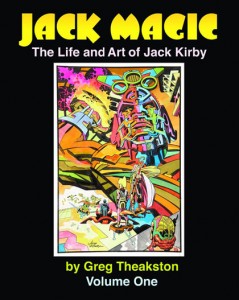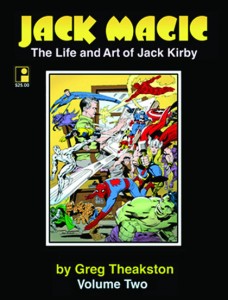Greg Theakston, Jack Magic: The Life and Art of Jack Kirby, Volumes 1 and 2: A Review by Barry Pearl
(EDITOR’S NOTE: For ordering info on this limited-run book, follow this link to the review at the Jack Kirby Museum, where there are details at the bottom. We’ll keep you updated on the book’s availability.–Roy)
Who should read this book? This book is not for the causal comic book reader, but for someone who is knowledgeable in the history of comics, and of course, is interested in Jack Kirby and the rise of Marvel Comics.
Rating: I give this book a grade of C+. There is a grade “B” book in here, but the lack of editing, the abundance of sentence fragments, bad grammar, poor punctuation and, at times, stream of conscience irrelevancy diminishes the book.
In reading a biography or history book, I look to a few things to make it successful:
1. In it an interesting and compelling read. That is, do I enjoy reading this book and want to read more.
2. Is the author credible? Am I getting the facts and how does the author convey to me his authenticity.
3. Is there anything new here? I have read books that pretend to be history or biographies, but they have no new thought or ideas and just regurgitate what other people have written.
So a completely factual book may read like a textbook and not be very compelling, although sometimes that is necessary. I also want to know if the author done his research?
In cases like Ronald Reagans bio, the author puts himself in the book. Doris Kearns Goodwin, brilliantly tells the story of the Brooklyn Dodgers through her own eyes in Just Wait Til Next Year. And she calls it a memoir, not a history of the Dodgers.
This is an important introduction to this review of Greg Theakston’s Jack Magic: The Life and Art of Jack Kirby Volumes One and Two. (Volume two begins just after Fantastic Four #1 and 2 were printed.)
Theakston tries to often to put himself into the story. On the very first page, Theakston describes using the same toilet as Jack Kirby. This is too much information. These become a strange and at times disappointing merger of a personal memoir and a biography of Jack Kirby.
Theakston has some important and informative interviews with Kirby dispersed throughout his narrative. However, he does not give us the dates of these interviews. Nor does Theakston give us any footnotes, although there are references to a Joe Simon book and to a huge amount of interviews done in various Tomorrows publications (especially the Jack Kirby Collector #10). He also does give credits to many direct quotes. So there is an implication here that Kirby confided many details to Theakston about specific parts of his life. But there is nothing really concrete that Kirby contributed to those specific topics. Theakston even asks us on several occasions to take himself at his word. For example, when discussing Martin Goodman he urges us to, “Believe me, I’ve followed this guy’s career.” In cut and pasting in from other publication, it often feels that the context was missing.
It further stretches credibility, when, in Volume II, Theakston states that he cannot list the amount Goodman sold Marvel for in 1968 because he could not find it on the internet. Well, how much of this book came from the internet and which parts came from where? The internet is not reliable. Theakston claims Goodman was making $25,000,000 a year. (Where did he get this figure?) Well, in the book Stan Lee and the Rise and Fall of the American Comic states that he Goodman sold Marvel for $15,000,000. Someone’s information therefore has to be incorrect; no one sells a company that is making $25 mil a year for $15 mil.
Theakston is at his best describing the actual work Kirby did for Victor Fox, DC, Goodman and on books like Blue Bolt and such like that. I also like it when authors discuss real money, mention that Kirby got $15 a page, or that Simon rented an office for $25. However, Theakston, especially in the second volume, begins to tell us what “inflation adjusted” value of the money is, but gives no formula for that determination. Then, he stops listing the actual money and gives just his inflation adjustment figures, as if to shock us. But is it accurate?
There is a lot of artwork, presented in black and white, from Kirby’s early days. These were really fascinating to see.
The book’s narrative is often interrupted by Theakston stream of consciousness writing, where he keeps putting in his omnipresent observation. For example: when Kirby gives a two sentence example good and bad yelling at each other, Theakston chimes in with, “Basically that’s all super-hero comics are about.’ Or when mentioning Blue Bolt, Theakston buts in “Look, at the time audiences didn’t expect much.” But so much of this condescending attitude runs through the book and disrupts the narrative.
Theakston doesn’t place Simon and Kirby’s leaving of Marvel in its chronological place, instead he gets back to it, totally blaming Goodman for not giving them royalties. There is no balance here, nor an attempt to present Goodman’s view, Theakston just concludes that Kirby as “robbed.” I wonder how Goodman felt when he discovers that his highly paid creative team was moonlighting at this competitor.
Although Kirby always credited Ed Herron for the creation of the Red Skull, Simon, since Kirby has passed on, takes full credit for it. Glad Theakston gets into this.
The book is at its best describing Kirbys work (and military life) for the remainder of the 1940’s and throughout the 1950s. I don’t want to minimize this part, Theakston holds his interactivity to a minimum and these chapters are informative. A lot of time is spent on the conflict with Jack Schiff over Sky Master, but the judgment against Kirby, the coda to the story, is not given.
The photos of Jack and his family and friends are great. Theakston also has a lot of covers and plash pages in black and white as well as many pieces of artwork either not published or hard to find.
Theakston first book takes us through the creation of the Fantastic Four in a more balanced way than I have seen many Kirby people present. However, this leaves us with not just an ambiguous ending, but an ungrammatical one, perhaps hoping will buy volume 2.
Volume 2 easily picks up exactly where Volume I leave off. Theakston, with an even hand, goes through there “Fly” and Simon period of the late 1950s, with extensive quotes from Joe Simon’s book. This means Theakston wrote this section recently. He covers, with interesting quotes, the creation of the entire cadre of Marvel heroes, including Sgt. Fury. Fury is an important concept because it shows that Goodman was looking at comics from the point of view of a business man, not a creative person.
Theakston included copies of Stan’s story outlines, which are fascinating to read.
Greg points out that after Daredevil, Marvel waited years before releasing a new title. What Greg doesn’t explain is that first, Marvel was limited by Independent Distributers, to the amount of comics Marvel could publish; they were at their limit. So to get a new comic, you have to cancel an old one, but all the comics were selling well. After DD, The Torch and Giant Man were removed from their anthology titles and replaced by Nick Fury and the Sub-Mariner. So this section seems incomplete, although what is there seems accurate. He later does get to Nick Fury, but I wished the book was more chronological, rather than jumping around.
In discussing the 1970s DC year Theakston does confirm something I had heard many times, that Vince Colletta was showing Marvel Kirby’s work and telling him what he was working on. I believe it was Mark Evanier who explained that once Stan found out Kirby was working on a Dracula story he added both Morbius and Dracula to the Marvel line up.
Theakston though, arrives at conclusions I don’t see. For example, when Kirby returns to Marvel and does the Silver Surfer graphic Novel, Greg contends that if it was a successful movie it would have made it to Broadway. Well, this was 1977, and at that time only ONE comic book character ever made it to Broadway, Superman and that didn’t last long. But these are the steps he takes.
Kirby’s last years, his disputes with Marvel, his work in animation and much more are presented here, often mixed in with Theakston’s personal stories, which I felt took me out of the book and made it harder to read than it should have. But there is some good and important stuff here that is important.
I am tempted to make a point and end with a sentence fragment. But, seriously, a good editor not only could have elevated this book to a “B” but made it a more enjoyable read.



